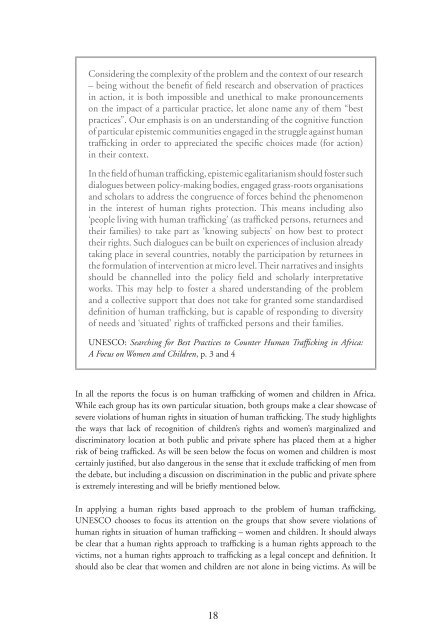Trafficking in human beings: human rights and ... - unesdoc - Unesco
Trafficking in human beings: human rights and ... - unesdoc - Unesco
Trafficking in human beings: human rights and ... - unesdoc - Unesco
Create successful ePaper yourself
Turn your PDF publications into a flip-book with our unique Google optimized e-Paper software.
Consider<strong>in</strong>g the complexity of the problem <strong>and</strong> the context of our research<br />
– be<strong>in</strong>g without the benefi t of fi eld research <strong>and</strong> observation of practices<br />
<strong>in</strong> action, it is both impossible <strong>and</strong> unethical to make pronouncements<br />
on the impact of a particular practice, let alone name any of them “best<br />
practices”. Our emphasis is on an underst<strong>and</strong><strong>in</strong>g of the cognitive function<br />
of particular epistemic communities engaged <strong>in</strong> the struggle aga<strong>in</strong>st <strong>human</strong><br />
traffi ck<strong>in</strong>g <strong>in</strong> order to appreciated the specifi c choices made (for action)<br />
<strong>in</strong> their context.<br />
In the fi eld of <strong>human</strong> traffi ck<strong>in</strong>g, epistemic egalitarianism should foster such<br />
dialogues between policy-mak<strong>in</strong>g bodies, engaged grass-roots organisations<br />
<strong>and</strong> scholars to address the congruence of forces beh<strong>in</strong>d the phenomenon<br />
<strong>in</strong> the <strong>in</strong>terest of <strong>human</strong> <strong>rights</strong> protection. This means <strong>in</strong>clud<strong>in</strong>g also<br />
‘people liv<strong>in</strong>g with <strong>human</strong> traffi ck<strong>in</strong>g’ (as traffi cked persons, returnees <strong>and</strong><br />
their families) to take part as ‘know<strong>in</strong>g subjects’ on how best to protect<br />
their <strong>rights</strong>. Such dialogues can be built on experiences of <strong>in</strong>clusion already<br />
tak<strong>in</strong>g place <strong>in</strong> several countries, notably the participation by returnees <strong>in</strong><br />
the formulation of <strong>in</strong>tervention at micro level. Their narratives <strong>and</strong> <strong>in</strong>sights<br />
should be channelled <strong>in</strong>to the policy fi eld <strong>and</strong> scholarly <strong>in</strong>terpretative<br />
works. This may help to foster a shared underst<strong>and</strong><strong>in</strong>g of the problem<br />
<strong>and</strong> a collective support that does not take for granted some st<strong>and</strong>ardised<br />
defi nition of <strong>human</strong> traffi ck<strong>in</strong>g, but is capable of respond<strong>in</strong>g to diversity<br />
of needs <strong>and</strong> ‘situated’ <strong>rights</strong> of traffi cked persons <strong>and</strong> their families.<br />
UNESCO: Search<strong>in</strong>g for Best Practices to Counter Human Traffi ck<strong>in</strong>g <strong>in</strong> Africa:<br />
A Focus on Women <strong>and</strong> Children, p. 3 <strong>and</strong> 4<br />
In all the reports the focus is on <strong>human</strong> traffi ck<strong>in</strong>g of women <strong>and</strong> children <strong>in</strong> Africa.<br />
While each group has its own particular situation, both groups make a clear showcase of<br />
severe violations of <strong>human</strong> <strong>rights</strong> <strong>in</strong> situation of <strong>human</strong> traffi ck<strong>in</strong>g. The study highlights<br />
the ways that lack of recognition of children’s <strong>rights</strong> <strong>and</strong> women’s marg<strong>in</strong>alized <strong>and</strong><br />
discrim<strong>in</strong>atory location at both public <strong>and</strong> private sphere has placed them at a higher<br />
risk of be<strong>in</strong>g traffi cked. As will be seen below the focus on women <strong>and</strong> children is most<br />
certa<strong>in</strong>ly justifi ed, but also dangerous <strong>in</strong> the sense that it exclude traffi ck<strong>in</strong>g of men from<br />
the debate, but <strong>in</strong>clud<strong>in</strong>g a discussion on discrim<strong>in</strong>ation <strong>in</strong> the public <strong>and</strong> private sphere<br />
is extremely <strong>in</strong>terest<strong>in</strong>g <strong>and</strong> will be briefl y mentioned below.<br />
In apply<strong>in</strong>g a <strong>human</strong> <strong>rights</strong> based approach to the problem of <strong>human</strong> traffi ck<strong>in</strong>g,<br />
UNESCO chooses to focus its attention on the groups that show severe violations of<br />
<strong>human</strong> <strong>rights</strong> <strong>in</strong> situation of <strong>human</strong> traffi ck<strong>in</strong>g – women <strong>and</strong> children. It should always<br />
be clear that a <strong>human</strong> <strong>rights</strong> approach to traffi ck<strong>in</strong>g is a <strong>human</strong> <strong>rights</strong> approach to the<br />
victims, not a <strong>human</strong> <strong>rights</strong> approach to traffi ck<strong>in</strong>g as a legal concept <strong>and</strong> defi nition. It<br />
should also be clear that women <strong>and</strong> children are not alone <strong>in</strong> be<strong>in</strong>g victims. As will be<br />
18

















